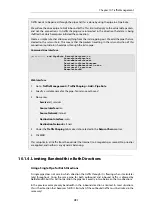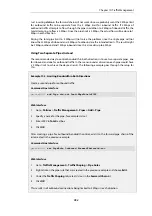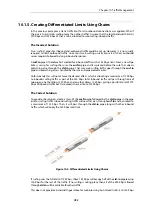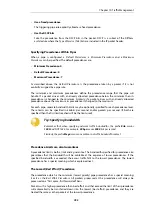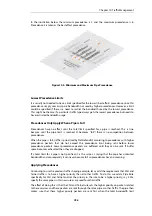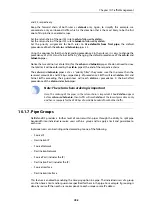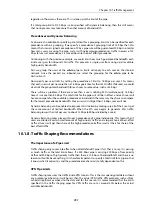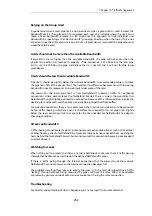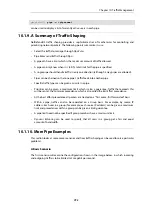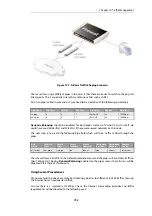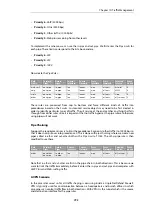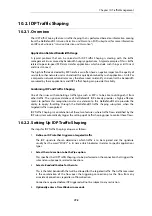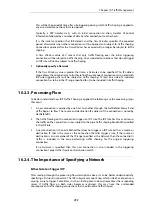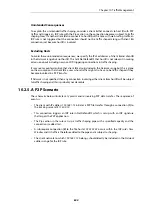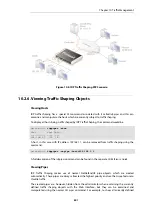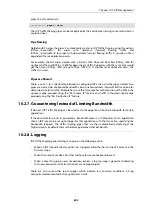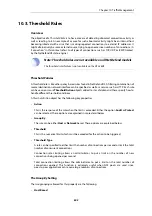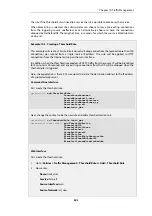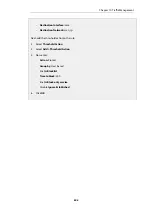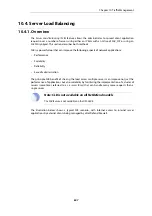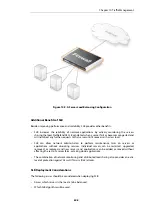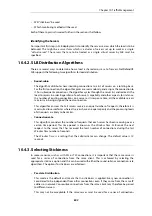
•
Priority 6 - VoIP (500 Kbps)
•
Priority 4 - Citrix (250 Kbps)
•
Priority 2 - Other traffic (1000 Kpbs)
•
Priority 0 - Web plus remaining from other levels
To implement this scheme, we can use the
in-pipe
and
out-pipe
. We first enter the
Pipe Limits
for
each pipe. These limits correspond to the list above and are:
•
Priority 6 -
500
•
Priority 4 -
250
•
Priority 2 -
1000
Now create the
Pipe Rules
:
Rule
Name
Forward
Pipes
Return
Pipes
Source
Interface
Source
Network
Dest
Interface
Dest
Network
Selected
Service
Prece
dence
web_surf
out-pipe
in-pipe
lan
lannet
wan
all-nets
http-all
0
voip
out-pipe
in-pipe
lan
lannet
wan
all-nets
H323
6
citrix
out-pipe
in-pipe
lan
lannet
wan
all-nets
citrix
4
other
out-pipe
in-pipe
lan
lannet
wan
all-nets
all_services
2
These rules are processed from top to bottom and force different kinds of traffic into
precedences based on the
Service
. Customized service objects may need to be first created in
order to identify particular types of traffic. The
all
service at the end, catches anything that falls
through from earlier rules since it is important that no traffic bypasses the pipe rule set otherwise
using pipes will not work.
Pipe Chaining
Suppose the requirement now is to limit the precedence 2 capacity (other traffic) to 1000 Kbps so
that it does not spill over into precedence 0. This is done with
pipe chaining
where we create new
pipes called
in-other
and
out-other
both with a
Pipe Limit
of 1000. The
other
pipe rule is then
modified to use these:
Rule
Name
Forward
Pipes
Return
Pipes
Source
Interface
Source
Network
Dest
Interface
Dest
Network
Selected
Service
Prece
dence
other
out-other
out-pipe
in-other
in-pipe
lan
lannet
wan
all-nets
all_services
2
Note that
in-other
and
out-other
are first in the pipe chain in both directions. This is because we
want to limit the traffic immediately, before it enters the
in-pipe
and
out-pipe
and competes with
VoIP, Citrix and Web-surfing traffic.
A VPN Scenario
In the cases discussed so far, all traffic shaping is occurring inside a single NetDefend Firewall.
VPN is typically used for communication between a headquarters and branch offices in which
case pipes can control traffic flow in both directions. With VPN it is the tunnel which is the source
and destination interface for the pipe rules.
Chapter 10: Traffic Management
795
Summary of Contents for NetDefendOS
Page 30: ...Figure 1 3 Packet Flow Schematic Part III Chapter 1 NetDefendOS Overview 30 ...
Page 32: ...Chapter 1 NetDefendOS Overview 32 ...
Page 144: ...Chapter 2 Management and Maintenance 144 ...
Page 284: ...Chapter 3 Fundamentals 284 ...
Page 392: ...Chapter 4 Routing 392 ...
Page 419: ... Host 2001 DB8 1 MAC 00 90 12 13 14 15 5 Click OK Chapter 5 DHCP Services 419 ...
Page 420: ...Chapter 5 DHCP Services 420 ...
Page 573: ...Chapter 6 Security Mechanisms 573 ...
Page 607: ...Chapter 7 Address Translation 607 ...
Page 666: ...Chapter 8 User Authentication 666 ...
Page 775: ...Chapter 9 VPN 775 ...
Page 819: ...Chapter 10 Traffic Management 819 ...
Page 842: ...Chapter 11 High Availability 842 ...
Page 866: ...Default Enabled Chapter 13 Advanced Settings 866 ...
Page 879: ...Chapter 13 Advanced Settings 879 ...

